
A comic book, also called comicbook, comic magazine or simply comic, is a publication that consists of comics art in the form of sequential juxtaposed panels that represent individual scenes. Panels are often accompanied by descriptive prose and written narrative, usually, dialogue contained in word balloons emblematic of the comics art form. Although comics have some origins in 18th century in Eastern Asia, comic books were first popularized in the United States and the United Kingdom during the 1930s. The first modern comic book, Famous Funnies, was released in the US in 1933 and was a reprinting of earlier newspaper humor comic strips, which had established many of the story-telling devices used in comics. The term comic book derives from American comic books once being a compilation of comic strips of a humorous tone; however, this practice was replaced by featuring stories of all genres, usually not humorous in tone.

Spider-Man is a superhero appearing in American comic books published by Marvel Comics. Created by writer-editor Stan Lee and artist Steve Ditko, he first appeared in the anthology comic book Amazing Fantasy #15 in the Silver Age of Comic Books. He has since been featured in movies, television shows, video games, and plays. Spider-Man is the alias of Peter Parker, an orphan raised by his Aunt May and Uncle Ben in New York City after his parents Richard and Mary Parker died in a plane crash. Lee and Ditko had the character deal with the struggles of adolescence and financial issues and gave him many supporting characters, such as Flash Thompson, J. Jonah Jameson and Harry Osborn; romantic interests Gwen Stacy, Mary Jane Watson and the Black Cat; and foes such as Doctor Octopus, the Green Goblin and Venom. In his origin story, he gets spider-related abilities from a bite from a radioactive spider; these include clinging to surfaces, superhuman strength and agility, and detecting danger with his "spider-sense." He also builds wrist-mounted "web-shooter" devices that shoot artificial spider webs of his own design.

Stephen J. Ditko was an American comics artist and writer best known as artist and creator of the Marvel superheroes Spider-Man and Doctor Strange.

Watchmen is an American comic book maxiseries by the British creative team of writer Alan Moore, artist Dave Gibbons and colorist John Higgins. It was published monthly by DC Comics in 1986 and 1987 before being collected in a single-volume edition in 1987. Watchmen originated from a story proposal Moore submitted to DC featuring superhero characters that the company had acquired from Charlton Comics. As Moore's proposed story would have left many of the characters unusable for future stories, managing editor Dick Giordano convinced Moore to create original characters instead.
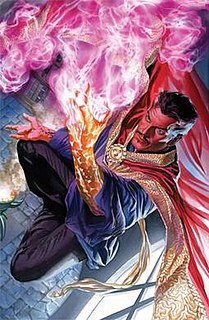
Doctor Stephen Strange is a fictional character appearing in American comic books published by Marvel Comics. Created by Steve Ditko with Stan Lee, the character first appeared in Strange Tales #110. Doctor Strange serves as the Sorcerer Supreme, the primary protector of Earth against magical and mystical threats. Strange was created during the Silver Age of Comic Books to bring a different kind of character and themes of mysticism to Marvel Comics.

Charlton Comics was an American comic book publishing company that existed from 1945 to 1986, having begun under a different name: T.W.O. Charles Company, in 1940. It was based in Derby, Connecticut. The comic-book line was a division of Charlton Publications, which published magazines, puzzle books and, briefly, books. It had its own distribution company.

Rorschach is a fictional antihero in the graphic novel limited series Watchmen, published by DC Comics in 1986. Rorschach was created by writer Alan Moore with artist Dave Gibbons, but as with most of the main characters in the series, he was an analogue for a Charlton Comics character, in this case Steve Ditko's the Question. Moore also modeled Rorschach on Mr. A, another Steve Ditko creation on whom the Question was originally based.

Wallace Allan Wood was an American comic book writer, artist and independent publisher, widely known for his work on EC Comics's titles such as Weird Science, Weird Fantasy, and MAD Magazine from its inception in 1952 until 1964, as well as for T.H.U.N.D.E.R. Agents, and work for Warren Publishing's Creepy. He drew a few early issues of Marvel's Daredevil and established the title character's distinctive red costume. Wood created and owned the long-running characters Sally Forth and Cannon.

Plop!, "The New Magazine of Weird Humor!", was a comic book anthology series published by DC Comics in the mid-1970s. It falls into the horror / humor genre. It lasted 24 issues and the series ran from Sept./Oct. 1973 to Nov./Dec. 1976.
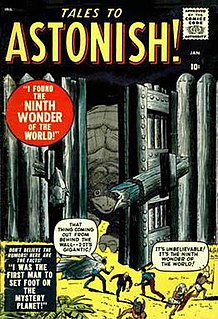
Tales to Astonish is the name of two American comic book series and a one-shot comic published by Marvel Comics.

The Fly is a fictional comic book superhero first published in 1959 by Red Circle Comics. He was created by Joe Simon as part of Archie's "Archie Adventure Series" and later camped up as part of the company's Mighty Comics line. He first appeared in The Double Life of Private Strong #1; however, his origin story and first "full-length" appearance were in Adventures of the Fly #1.

witzend, published on an irregular schedule spanning decades, is an underground comic showcasing contributions by comic book professionals, leading illustrators and new artists. witzend was launched in 1966 by the writer-artist Wallace Wood, who handed the reins to Bill Pearson from 1968 to 1985. The title was printed in lower-case.

Doctor Anthony Druid, also known as Doctor Droom and Druid, is a fictional mystic and a supernatural monster-hunter appearing in American comic books published by Marvel Comics. Co-created by writer-editor Stan Lee and penciller Jack Kirby, he debuted as Dr. Anthony Droom in Amazing Adventures #1, published in March, 1961. Kirby's art was inked by artist Steve Ditko. Dr. Droom appeared in four more issues of Amazing Adventures before his stories discontinued. Over a year later, artist Steve Ditko approached Stan Lee with a new magic character called Mr. Strange. Liking the idea, Stan Lee renamed the character Dr. Strange and wrote an origin story similar to Dr. Droom's. Dr. Anthony Droom was finally reintroduced to comics in 1976 in Weird Wonder Tales #19 in a retelling of his origin story which renamed him Dr. Anthony Druid. This retelling included new writing by Larry Leiber.
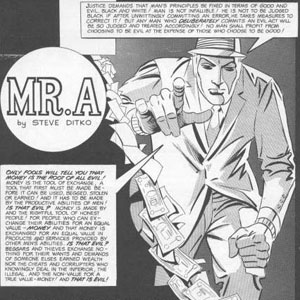
Mr. A is a fictional comic book hero created by Steve Ditko. Unlike most of Ditko's work, the character of Mr. A remained the property of Ditko, who wrote and illustrated the stories in which the character appeared entirely himself. The character first appeared in Wally Wood's witzend #3 (1967).
A script is a document describing the narrative and dialogue of a comic book in detail. It is the comic book equivalent of a television program teleplay or a film screenplay.
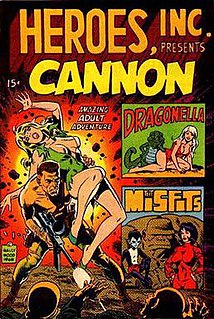
Heroes, Inc. Presents Cannon is a two-issue comic book series that represents one of the earliest independent comics. The first issue was self-published by prominent writer-artist Wally Wood in 1969, with a second issue published by CPL Gang Publications in 1976.

The Unexpected was a fantasy-horror comics anthology series, a continuation of Tales of the Unexpected, published by DC Comics. The Unexpected ran 118 issues, from #105 to #222. As a result of the so-called DC Implosion of late 1978, beginning in 1979 The Unexpected absorbed the other DC horror titles House of Secrets, The Witching Hour, and Doorway to Nightmare into its pages. Horror hosts featured in The Unexpected included The Mad Mod Witch, Judge Gallows, Abel, and the Witches Three.
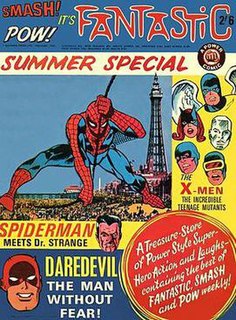
Fantastic was a weekly British comic book magazine published by Odhams Press under the Power Comics imprint. It first appeared on 18 February 1967, and with its 52nd issue on 10 February 1968 it merged with its sister title Terrific. The 89th and final issue of Fantastic appeared on 26 October 1968, after which it was merged into its sister title Smash!.

Fred Hembeck is an American cartoonist best known for his parodies of characters from major American comic book publishers. His work has frequently been published by the firms whose characters he spoofs. His characters are always drawn with curlicues at the elbows and knees. He often portrays himself as a character in his own work, in the role of "interviewer" of various comic book characters. Interviewer Daniel Best has said of his work, "If you take your comic books seriously, and think that those characters are real, then you're probably not a fan of Hembeck."
Alan Class Comics was a British comics publishing company that operated between 1959 and 1989. The company produced anthology titles, reprinting comics stories from many U.S. publishers of the 1940s to 1960s in a black and white digest size format for a UK audience. During the 1960s and 1970s, these reprints were the main medium through which British children were introduced to American monster and mystery comics, as well as most non-DC or Marvel superheroes.


















